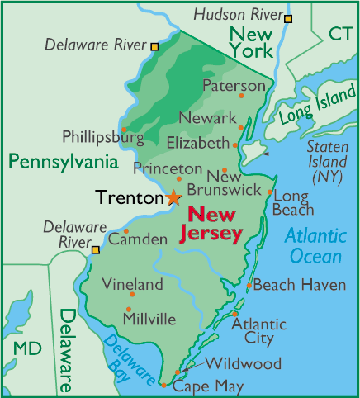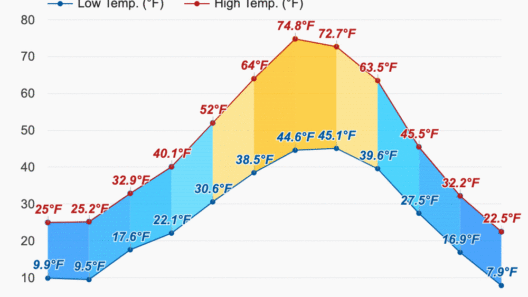New Jersey, a state encapsulating rich biodiversity and diverse ecosystems, presents a climate that is as varied as its landscapes. From the bustling shorelines of the Atlantic Ocean to serene suburban neighborhoods and sprawling forests, New Jersey’s meteorological patterns are impacted by a complex interplay of geographical features. But what exactly constitutes the climate of New Jersey? How do its unique geographical characteristics influence weather patterns, and what challenges does this pose for its residents?
New Jersey is situated in the Northeastern region of the United States, bordered by New York, Pennsylvania, and Delaware, with a significant coastline along the Atlantic. This strategic location plays a pivotal role in determining its climate. The state experiences a humid continental climate, characterized by four distinct seasons. Winters can be frigid and snowy, while summers tend to be hot and humid. Yet, within this general classification lies a tapestry of microclimates that vary significantly from one area to another.
During the winter months, average temperatures in northern regions often plummet, frequently falling below freezing, while southern coastal areas tend to experience milder conditions. This contrast is primarily due to the influence of the Atlantic Ocean, which moderates nearby temperatures. Ocean currents, prevailing winds, and geographical barriers all contribute to these fluctuations. A playful question arises: how might a winter storm in the northern reaches of Sussex County differ from a wintery day lounging on the beach at Cape May?
Spring is a transformative season in New Jersey, where the environment gradually awakens from its wintry slumber. Cherry blossoms bloom, and green buds begin to emerge, offering a stark contrast to the drabness of winter. Average temperatures fluctuate between 45°F (7°C) and 65°F (18°C). Rain showers become more frequent, setting the stage for lush growth. Such seasonal shifts, however, come with their own peculiar challenges. Increased precipitation can lead to flash flooding, particularly in areas like the Delaware River basin, posing a risk to both infrastructure and natural habitats.
Summer, on the other hand, envelops New Jersey with warmth and humidity. Expect temperatures to often soar over 85°F (29°C), with occasional heat waves pushing the mercury even higher. This steamy environment creates a vibrant habitat for numerous species, but it also raises the specter of droughts and heat-related illnesses among residents. Moreover, the alluring beaches can become overcrowded tourist hotspots, bringing both economic opportunities and environmental challenges such as beach erosion and marine ecosystem disruption.
As summer yields to fall, New Jersey undergoes a spectacular metamorphosis. The foliage transforms into a colorful tapestry of oranges, reds, and yellows, attracting leaf-peepers from near and far. Autumn temperatures range from a comfortable 40°F (4°C) to 70°F (21°C), allowing for outdoor festivities to flourish. However, this season also serves as a precursor to severe weather events, such as hurricanes and tropical storms that can strike the state, particularly from August through October. The duality of beauty and peril is an endemic condition of New Jersey’s climate that requires resilience and preparedness from its inhabitants.
The complexity of New Jersey’s climate is further compounded by climate change. Rising sea levels threaten its coastal communities, while fluctuating weather patterns pose significant hurdles for agricultural sectors. Farmers have already felt the tangible effects of shifting growing seasons, pushing them to adapt to new realities. The irony of having a state rich in resources facing existential threats challenges the prevailing narratives about sustainability and conservation.
Moreover, urbanization amplifies climate-induced challenges. The suburban sprawl contributes to heat islands, where urban areas absorb and retain more heat than their rural surroundings. This phenomenon exacerbates electrical needs during scorching summers, forcing residents to grapple with higher energy bills as they attempt to stay cool. Can New Jersey, a state steeped in innovation, find creative solutions to combat these climate-induced issues?
Another looming challenge is the state’s ecology, which is as varied as its climate. Natural habitats are vulnerable to incursion from invasive species that thrive in shifting climates, disrupting established ecosystems. Conservation efforts are paramount to protect biodiversity, but they necessitate collaboration among government agencies, local communities, and environmental advocates.
The rivers and bays of New Jersey also bear the brunt of climate change, with changing salinity levels affecting fish populations and water quality. These ecosystems are vital for both commercial fishing and recreational activities, drawing tourists and locals alike. Enhancing policies on water conservation and pollution control becomes essential to preserve these precious resources.
In conclusion, New Jersey encapsulates the paradox of being a climate microcosm, illustrating both the beauty and fragility of the environment. From the snowy landscapes of winter to the sultry beaches of summer, the state invites introspection about its climate challenges. As residents and policymakers ponder how to mitigate the prodigious impacts of climate change, bold actions, innovative strategies, and a communal approach are vital. Indeed, exploring New Jersey’s climate is not merely an academic endeavor; it is a clarion call to protect the ecosystem that nurtures its residents and visitors alike.







